Château Carbonnieux
by
Terry Sullivan
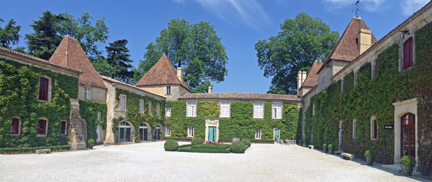 Summary: Vineyards were farmed on this property since the time of the Benedictine monks during the 13th century. Discover the history of Château Carbonnieux and visit a winery where America’s third president visited and drank wines.
Summary: Vineyards were farmed on this property since the time of the Benedictine monks during the 13th century. Discover the history of Château Carbonnieux and visit a winery where America’s third president visited and drank wines.
There is a long history of wine at Château Carbonnieux. It was originally a farm, with a smaller château built under the four towers. Benedictine monks occupied the estate in the 13th century and again in the 18th century. The monks tended vineyards and made wine. The monks were from the Abbaye de Sainte-Croix de Bordeaux. Over the centuries, the estate was taken or sold to others. The Benedictine monks returned in the 1700s. The château was damaged during the French Revolution and sold to several other owners during the next two centuries. Then in 1956, the château was acquired by Marc Perrin, and his son, Anthony. They made technical improvements. Today, Anthony’s children, Eric and Philibert manage the property. During our visit we met Eric who conducted our wine tasting.
The Château and vineyards are located in the Pessac-Léognan appellation of Bordeaux.
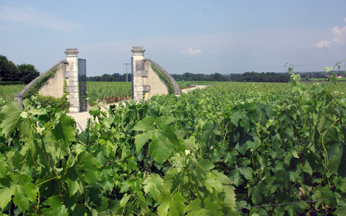 Vineyard
Vineyard
The vineyards lay over 95 hectares with plantings of Cabernet Sauvignon, Merlot, Cabernet Franc and Petit Verdot for the reds. The soil for the red grapes depends on the variety planted. Cabernet Sauvignon is planted in soils that have deep gravel while Merlot is planted in soils of fine gravel and clay. Cabernet Franc and Petit Verdot are planted in soils made of a thin layer of gravel, followed by clay and limestone. The age of the red wine grapes in the vineyard is 27 years. A bit older are the grapevines used to make white wines. Semillon and Sauvignon Blanc vines are 30 years old. Sauvignon Blanc is well adapted to the soils. It is planted in deep gravel soils as well as clay/limestone soils. Semillon is planted in clay/limestone soils. The vines will be replanted approximately every 65 years.
Winery
When white wine grapes come into the winery, they are placed in tanks for several hours for maceration on the skins. They are then pressed and placed in vats. After fermentation, the wine is placed in oak barrels and stirred several times to mix the lees. There is no malolactic fermentation on the white wines. White wines age for nine to ten months. The red wines ferment in vats and are put into barrels for malolactic fermentation and aging. Grand crus age for 18 months while the château’s second label ages for 12 months. Blending the wines are done after aging.
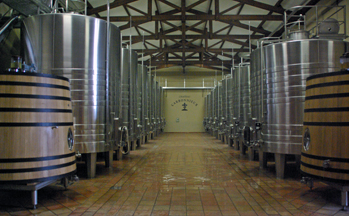
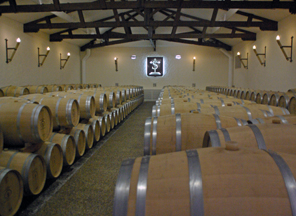
At the time of our visit, barrels were stacked two high. In the barrel room there is a statue of the Reverent Father Dom Galléas, a Benedictine and patron of the Bordeaux wine region. It was Dom Galléas who received Thomas Jefferson on May 25th in 1787. Jefferson visited Château Carbonnieux, ordered wine and spoke with Father Galléas. A plaque on the wall commemorates the visit.
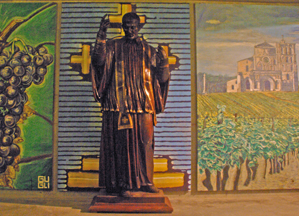
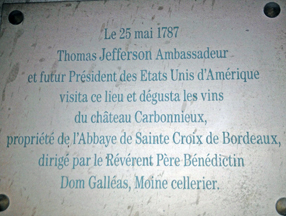
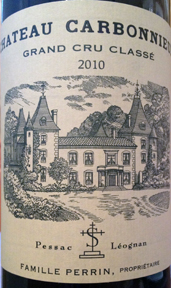 Wines
Wines
The wine tasting room is large with plenty of room for tasting wines. Adjacent to the wine tasting room there is a room housing several antique automobiles. Eric collects vintage cars.
Our tasting began with a white wine, the 2011 Château Carbonnieux Cru Clasé de Graves Pessac-Léognan. The light yellow wine was a blend of 70 percent Sauvignon Blanc and 30 percent Semillon. The wine’s aroma and taste reminded me of a fruit cocktail. The finish was crisp and there were notes of tropical fruit and lemon. The red wine we tasted was a 2010 Château Carbonnieux Cru Clasé de Graves Pessac-Léognan. The wine was a blend of Cabernet Sauvignon at 65 percent, Merlot at 30 percent and Cabernet Franc at 5 percent. The wine was a dark ruby color with a ruby rim. There were dark fruits and leather on the aroma, while the taste offered cherries, blackberries and cassis. The wine had bold tannins and a fruity finish that yielded to oak influences.
The estate is opened Mondays to Fridays year round. Call to make an appointment. While visiting take time to view the vineyards and soil. Learn about the rich history of the estate that spans several centuries.
Château Carbonnieux
Chemin de Peyssardet
F-33850 Léognan, France
33(0)5 57 96 56 20
Visit these tour operators that partner with Wine Trail Traveler.
 |
||||
France
|
France
|
France | SmoothRed London, England, United Kingdom |


